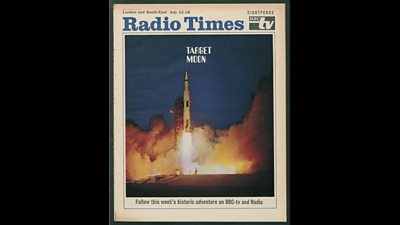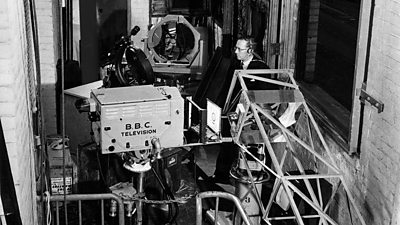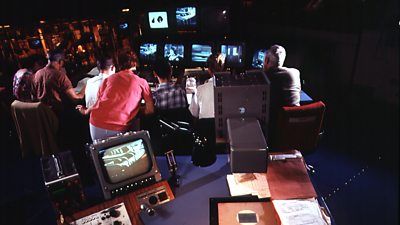Image: Off-screen picture of American astronaut Neil Armstrong (Flight Commander) walking on the surface of the moon, taken during a live transmission on ���˿��� One, Monday 21st July 1969.
July 21 at 02:56:15 UTC - the precise moment when Neil Armstrong became the first man to step onto the lunar surface. It was an extraordinary achievement, was hailed by some as one of the greatest moments in science, and was hugely envied by Soviet competitors. Certainly it proved to be a great leap forward in covering live events for the ���˿���.
A mammoth 27 hours of coverage over ten days had the UK gripped. 50 years on, ���˿��� History Manager John Escolme revisits the historic broadcasts with James Burke, one of the main presenters during the mission, and dips into hitherto un-released interviews from the ���˿��� Oral History Collection, to re-examine what that extraordinary coverage meant for the ���˿���, its audience, and science.

All in the planning
Planning 27 hours of ���˿��� TV coverage is no small undertaking in any era, but looking back to the late 1960s, with the technology available then, it seems amazing it ever happened at all.
By summer 1969, only ���˿��� Two had progressed to broadcasting in colour, the other two UK TV channels laboured on in lower definition black and white.
Live TV by satellite had been achieved by 1962, and the European Broadcasting Union and ���˿��� had successfully linked every continent by satellite by 1967, but the technology was expensive to use, and its capacity still very limited.
However, the constraints didn’t stop the ���˿��� stepping up to the challenge. It decided it would broadcast the Apollo mission in its entirety.
For good measure, the Corporation also added the broadcast of the mission to the world beyond America, to its list of responsibilities.
The ���˿��� also electronically converted the American standard pictures that reached earth via Houston, using equipment of its own design, and sent them around the world in partnership with the European Broadcasting Union.
Once it understood the enormity of the task, and had defined its commitments, some specific, almost comical problems started to arise.
Broadcasting the Apollo 11 mission almost never happened, thanks to a baseball game scheduled to be broadcast to Puerto Rico at the same time.
Sir Richard Francis Head of Special projects for the ���˿��� in the late 60s, and stationed in the U.S. at the time of the Apollo missions, explained this extraordinary situation to Frank Gillard in his 1986 interview for the ���˿��� Oral History Collection.
James Burke for the hot-seat
Once these obstacles were out of the way, it was time to get the ���˿��� TV on-screen team together for the Apollo 11 mission.
Who would front such an important broadcast?
Since 1966 James Burke had presented and reported for the ���˿���'s Science and Features Department, and had made his mark fronting the flagship science magazine programme Tomorrow's World.
His writing on popular science, and his highly regarded book of the Tomorrow's World series was an instant success, and to ���˿��� managers, these credits made him the perfect fit to present the Apollo mission programmes.
However, before the broadcast, Burke knew practically nothing about space flight, and shuddered at the thought of presenting hours of continuous television whilst attempting to sound knowledgeable.
The most historic journey in the history of Man, perhaps
Increasing sophistication
By 1969, production techniques had come a long way since ���˿��� TV first ‘televised the moon’ in 1949.
From the studios at Alexandra Palace, wobbly images of the moon had then been reproduced using a series of mirrors, and broadcast to a not so impressed audience.

Widespread public interest in space only came when TV could genuinely follow a mission in outer space, a fascination that peaked with Apollo 11 – the great moon-walk moment.
Longer and longer sequences of programmes covering each Apollo mission became ever more sophisticated.
The broadcasts transferred from the very cramped two studio set up at Alexandra Palace to the colour equipped studio 7 at Lime Grove.
Some programmes came from Television Centre, making the Apollo 11 programmes a much more glossy (and watchable) affair.
For Apollo 11, ���˿��� One was to stay on air continuously for 11 hours from 23.30 (July 20) until 10.30 (July 21). This in itself was a landmark for the ���˿��� - being its first all-night broadcast.
���˿��� Two would broadcast parts of the mission in colour, another innovation for a European broadcaster.
The ever popular Cliff Michelmore would anchor all the main broadcasts, leaving Burke and Patrick Moore to analyse the technical aspects and concentrate on the real science of the mission. Moore had a seemingly endless stream of maps of the moon’s surface at the ready, and swept into excited and energetic detail at a moment’s notice.
Burke’s vast amount of research into space flight paid off, and he was able to fill long gaps in the lunar action with informed comment. However for him, knowing how much of this to reveal was critical.
Bridging the gap between two worlds was an awesome achievement
A horserace with satellites
Keeping such long hours of television on air, required highly detailed logistics. Yet with only two months from broadcasting the previous mission, Apollo 10, an altogether more modest affair, there was very little time to get coverage of the most historic mission fit for continuous TV.
Executive Producer Dick Francis was the mastermind behind the Apollo transmissions for the ���˿��� - a man Burke recalls as ‘one of the best and most professional people I’ve ever worked with”.
It was Francis’ job to organise studios, crews and access to satellites.
The greatest media event of all time
One chance to get it right
With many hours of Apollo coverage already under their belts, the presenting and production team were ready to broadcast 'the moment' – Neil Armstrong’s famous lunar walk.
On the day of the walk, ���˿��� One and Two broadcast two programmes.
The first was at .
The other, two hours later, covered the landing of the Eagle module, and lunar walk.
In the Lime Grove studios the presenters sat at a long desk with physical models of the Earth and moon to point at, behind them was a large image of the Saturn V rocket that had carried the Apollo module into space.
Virtual reality backdrops and 3D interpretations of statistics were but a dream in 1969.
However, electronic television captions had just been made possible, as Richard Francis recalls.
Knowledge and expertise from covering previous missions proved invaluable, now the broadcast from the moon’s surface had to be flawless.
The excitement was palpable, but for James Burke and all those in the studio, there was no awareness that history was being made. Broadcasting that moment was something you just had to get on with.
Are they going to have sufficient fuel to land on the moon, or are they going to have to abort very close to the lunar surface?
Just 17 seconds left
The journey to the moon was straightforward enough, but nearing touchdown there was a clear and obvious problem for the Apollo 11 crew. Fuel was running short, very short.
As much as James Burke would have liked to have explained to viewers the grave situation in detail as it unfolded live, he and his fellow presenters held back, but why?
Despite everything, touchdown was a success. The rest is history.
When Neil Armstrong stepped onto the moon's surface, the whole ���˿��� control room with the canteen ladies and security guards standing beside the vision control desk, exploded into cheering and clapping
A sigh of relief
The moon walk had been a success, and the ���˿��� TV broadcasting team had pulled it off.
Hours of broadcasting across two channels, had stretched ���˿��� resources, and had broken down many of the established working practices in TV at the time.
Press coverage was positive and because the on-air team had answered questions from the public on air throughout the mission, a positive connection between audience and the ���˿��� had been firmly established.

Legacy
What was the effect of the Apollo missions? Was there a lasting legacy for science, or broadcasting?
Following Apollo 11, James Burke suggested that no real science had come out of the landing, and that the missions were really a show for the media.
Fifty years on, does he still take that view?
With 16 million UK viewers at its peak, Apollo 11 was a significant media moment.
For the ���˿���, it established rules and conventions around continuous broadcasting, made highly technical information digestible for anyone watching at home, and brought disparate teams together from all over the Corporation for common cause.
What the missions did for science remains open for debate.
���˿��� programmes celebrating 50 years
-
���˿��� Four: The Sky at Night - The Moon, the Mission and the ���˿��� A look back through the archives showing how, with special assistance from Nasa, the ���˿��� reported the Apollo 11 mission, the first lunar expedition to put a man on the moon.
-
���˿��� iPlayer: The Space Race Programmes charting America and Russia's attempts to reach for the moon and beyond.
-
���˿��� Four Collections: Moon Landings Through over 40 years of radio and TV broadcasts, we meet the men who made that incredible journey and the reporters who brought their stories into our homes.
-
���˿��� Archive: Moon Landings These programmes and clips tell the story of the Apollo Moon missions, how they got off the ground and why the missions came to an abrupt end.
-
���˿��� Archive: Sky at Night A ���˿��� Archive collection of the Sky at Night.
-
���˿��� Two: 8 Days to the Moon and Back Using dramatic reconstruction, declassified cockpit audio recorded by the astronauts themselves and film archive, this is the untold story of the first moon landing.
-
���˿��� Four: Chasing the Moon The story of the race to the Moon, from the launch of Sputnik 1 in 1957 to Apollo 11, and the first man to set foot on the Moon, in 1969.
-
���˿��� Four: Sky at Night Return to the Moon Fifty years on, are we on the verge of a new golden age in lunar exploration?
-
Archive on 4 - James Burke: Our Man on the Moon James Burke, the key voice for the ���˿��� coverage of the moon landings in 1969, revisits the momentous event in front of a live audience.
-
���˿��� World Service: 13 Minutes to the Moon How the first moon landing was saved. The full story of the people who made Apollo 11 happen and prevented it from going badly wrong.
-
���˿��� CBeebies: The Moon Join Chris and Maggie at Stargazing Park and look up at the moon.
-
���˿��� Proms 2019: Prom 3: CBeebies: A Musical Trip to the Moon Young musical astronauts can follow in the footsteps of the Apollo 11 mission, experiencing new adventures along the way – including a meeting with the Clangers.
-
���˿��� Proms 2019: Proms Plus Talk 50 years to the day since men first walked on the Moon, Professor Richard Wiseman and Melanie Vandenbrouck, curator at the Royal Museums Greenwich reflect on the long footprint of those small steps.
-
���˿��� Proms 2019: Prom 4: The Planets Gustav Holst's masterpiece The Planets performed by the Bournemouth Symphony Orchestra.
-
���˿��� Proms 2019: Prom 27: The Sound of Space: Sci-Fi Film Music A Late Night Prom with a futuristic spin brings together some of the best sci-fi film music. Excerpts from cult soundtracks come together with recent works by Hans Zimmer and Mica Levi.
-
���˿��� Radio 4: Apollo 11 footage discovered The ���˿���'s library footage of Neil Armstrong's moon landing - which was missing, presumed lost forever - has been found by a viewer.
-
���˿��� News Science: 13 facts about Apollo 11 To accompany their podcast series 13 Minutes To The Moon, ���˿��� World Service present thirteen facts about the historic event.
-
Watch ���˿��� Bitesize's guide to the Earth, Sun and Moon.
-
The Apollo Program took eight years and cost some $25bn. But it overcame one of the most complex challenges humanity has ever undertaken – putting a man on the Moon.
Further reading
Your Memories
I remember this moment in history vividly. I was 10 years old. My family and I had gathered around our lone black and white television set to watch the historic moment. A few minutes before the actual landing our TV stopped working! My father briefly attempted to revive it with no success so we galloped to our neighbour's house and explained our dilemma. We ended up watching the moment with them in their home. Had they not been at home, my entire family and I would have most likely been left out of this historic event. I will never forget it and have relayed the story to my children many times. The moon landing is not just part of American - and world - history, it's also very much a part of our family history. On 20 July 1969, Neil Armstrong became the first man to walk on the moon.
- KERYN PAUL, OMAHA, NEBRASKA, USA
We watched the moon landing on a 1968 Bush TV, which was fairly newly bought so we could receive ���˿���2. At age 11, I had no real appreciation of just how risky and political the moon landing really was. My mum went to bed, but dad shouted up "500 feet to go" and she came down to see the final landing. There was a debate about whether the astronauts would do the walk right away or sleep first. So we went to bed at about 0100 or 0200. In the morning, we discovered they had just got on with it. My grandmother lived with us and I remember thinking how much change she had seen since her birth in the 1890s. A few days later our class teacher ran a session on the landing. It was the final week of my final year at primary school and so this was just about the last topic we covered. A few months later a pop record came out, Space Oddity by an unknown singer - David Bowie.
- JACK KIRK, DONCASTER, UK
I clearly remember watching the moon landings when I was five years old in Kuwait. We could not afford a television at the time so we squeezed into a neighbour's apartment with about six other families to watch it. It was the first time I can remember watching TV and the broadcast quality was grainy black and white. I didn't really understand it at the time watching these people bouncing around like balloons on the TV. However, I did sense that it was a moment of great importance. Everybody, including my parents and all our neighbours, were all watching it in a deep concentrated silence. I had never seen them all remain so quiet for so long - a record five minutes or so! It sparked a real spirit of innovation in us, because afterwards my parents said to me that if I study hard I can land on the moon or achieve anything I want. You could say it had a lasting impact, as I went on to become a fully qualified mechanical engineer.
- ANIL MATTHEW, DUBAI, UNITED ARAB EMIRATES
I was nine years old and I watched the landings with my dad in Ireland. We were living in Dublin at the time. For me as a nine-year-old and my dad, who was 30 years older than me, it was an equally important event. Right throughout the landing, I could not ignore this sense of being alive at this moment in time to be able to witness the single biggest achievement in the history of the human race. It was even more miraculous, considering the level of technology they had at their disposal at the time. Years later I even wrote songs about it, and I still enjoy recounting the feeling to people who weren't around or old enough at the time. The only thing that could beat that would be witnessing the first Mars walk. I will consider myself very lucky if my life spans those two landmark events.
- KEVIN SOLAN, RENNES, FRANCE
I was nine years old at the time. My family and I sat glued to our black and white set watching every movement of the spaceship and lunar module. The pictures to us were amazing and everything that happened was just so exciting. We couldn't believe what was happening. So as not to miss a single second my mum, instead of cooking meals, made what seemed to be millions of sandwiches and we lived on them for the duration of the event. I watched a moon landing programme with my 14-year-old daughter recently and she was just as mesmerised as I was all those years ago. When we watched the landings in 1969 I vowed then that I would one day go to Kennedy Space Centre and watch a rocket lift off. Thirty seven years later, we watched a space shuttle launch. Still just as exciting, still just as amazing.
- JUDI MURFITT, HULL, UK

